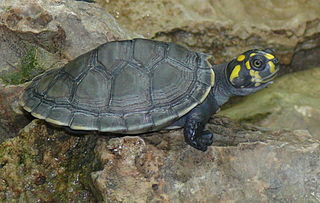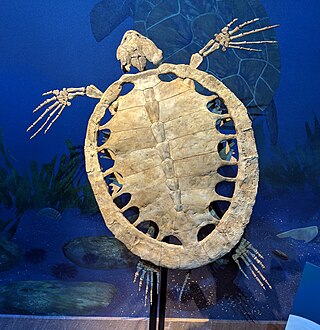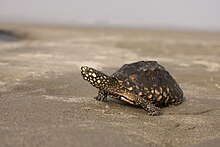
Podocnemididae is a family of pleurodire (side-necked) turtles, once widely distributed. Most of its 20 genera and 30 species are now extinct. Seven of its eight surviving species are native to South America: the genus Peltocephalus, with only one species ; and the genus Podocnemis, with six living species of South American side-necked river turtles. There is also one genus native to Madagascar: Erymnochelys, the Madagascan big-headed turtle, whose single species E. madagascariensis.

Chrysemys is a genus of turtles in the family Emydidae. They are found throughout most of North America.

Podocnemis is a genus of aquatic turtles, commonly known as South American river turtles, in the family Podocnemididae. The genus consists of six extant species occurring in tropical South America. Three additional species are known only from fossils.

The black pond turtle, also known commonly as the spotted pond turtle and the Indian spotted turtle, is a species of freshwater turtle in the family Geoemydidae. The species, which is endemic to South Asia, belongs to the monotypic genus Geoclemys.

Asian box turtles are turtles of the genus Cuora in the family Geoemydidae. About 12 extant species are recognized. The keeled box turtle is often included in this genus, or separated in the monotypic genus Pyxidea. Genus Cuora is distributed from China to Indonesia and the Philippines, throughout mainland Southeast Asia, and into northern India and Bhutan.

Macrochelys is a genus of very large freshwater turtles in the family Chelydridae, native to the Southeastern and Midwestern United States. Only a single extant species was recognized until 2014, when a study divided it into two, or possibly three species. These turtles are easily recognized by three distinct dorsal ridges with raised spikes.

Clemmys is a genus of turtles currently containing a single extant species, the spotted turtle (Clemmys guttata).

Sternotherus is a genus of turtles in the family Kinosternidae including six species commonly known as musk turtles. The genus is endemic to North America, occurring in the eastern third of the US and southeast Ontario, Canada. Musk glands positioned near the bridge of the shell can produce foul smelling secretions when the turtles are threatened, although gentle handling does not normally provoke a response. Sternotherus are moderately small turtles, with the largest species in the genus, the razor-backed musk turtle, attaining a maximum of 17.6 cm. in shell length. The carapace is characteristically oval and domed, with most species having one or three keels on the back which may become smoother and obscure with age in some species. Musk turtles are generally drab in color, mostly black, gray, brown, olive, or ocher, which aid in camouflaging them in their natural habitats. The head is relatively large and stout, marked with spots, streaks, or strips. The plastron has only 10 or 11 scutes, as opposed to 12, a more common condition in North American turtles. The tail is short, with males having a horny claw like tip.

Cycloderma is a genus of softshell turtles in the subfamily Cyclanorbinae of the family Trionychidae. The genus is endemic to Africa.

Hesperotestudo is an extinct genus of tortoise native to North and Central America from the Early Miocene to the Late Pleistocene. Species of Hesperotestudo varied widely in size, with a large undescribed specimen from the Late Pleistocene of El Salvador reaching 150 cm (4.9 ft) in carapace length, larger than that of extant giant tortoises. Historically considered a subgenus of Geochelone, it is now considered to be distantly related to that genus. Its relationships with other tortoises are uncertain. The exposed areas of the bodies of Hesperotestudo species were extensively covered with large dermal ossicles, which in life were covered in keratin. It has been suggested that species of Hesperotestudo were relatively tolerant of cold weather. Hesperotestudo became extinct at the end of the Pleistocene roughly co-incident with the arrival of the first humans in North America. There is apparently a site in Florida where one individual may have been killed that some suggested were evidence of butchering, although others suggested that the turtle was neither cooked nor does a ledge that was found near it date at the same time as it.

Euclastes is an extinct genus of sea turtles that survived the Cretaceous–Paleogene mass extinction. The genus was first named by Edward Drinker Cope in 1867, and contains three species. E. hutchisoni, was named in 2003 but has since been reassigned to the genus Pacifichelys, while E. coahuilaensis named in 2009 was reassigned as Mexichelys coahuilaensis in 2010.
Miocaretta is an extinct genus of sea turtle from the Miocene era in what is now Sri Lanka. It was first named by Paul E. P. Deraniyagala in 1967. The type and only species is M. lankae.
Syllomus is an extinct genus of sea turtle from the Miocene-age deposits in the US Eastern Seaboard and Egypt.
Chelydrops is an extinct genus of Chelydridae from Miocene of North America. Only one species is described, Chelydrops stricta.

Pacifichelys is an extinct genus of sea turtle from the Middle Miocene of Peru and California. It was first named by James F. Parham and Nicholas D. Pyenson in 2010, and the type species is Pacifichelys urbinai from Peru. A second species, P. hutchisoni, was reassigned from the genus Euclastes. It is known from the Miocene of California. Like the living Ridley and loggerhead sea turtles, Pacifichelys was durophagous, consuming hard-shelled organisms with crushing jaws.

Chelonoidis is a genus of turtles in the tortoise family erected by Leopold Fitzinger in 1835. They are found in South America and the Galápagos Islands, and formerly had a wide distribution in the West Indies.

Megalochelys is an extinct genus of tortoises that lived from the Miocene to Pleistocene. They are noted for their giant size, which is among the largest of any known testudine, with a maximum carapace length over 2 m (6.5 ft) in M. atlas. During the dry glacial periods it ranged from western India and Pakistan to as far east as Sulawesi and Timor in Indonesia, though the island specimens likely represent distinct species.
Rhinoclemmys panamaensis is an extinct species of turtle belonging to the genus Rhinoclemmys of the family Geoemydidae known from the early to middle Miocene (Hemingfordian) Cucaracha Formation of the Panama Basin of central Panama.
Lashari wala Forest is forest located near Taunsa Barrage, a ramsar site in Punjab Pakistan. Taunsa ramsar site is among 19 ramsar sites in Pakistan. Taunsa Barrage was designated a ramsar site on 22 March 1996. The western brink of Head Taunsa Barrage stretches around 5,000-km in Kot Adu Muzaffargarh District of South Punjab, Pakistan, about 90 km from Multan and 10 km from Kot Adu.














